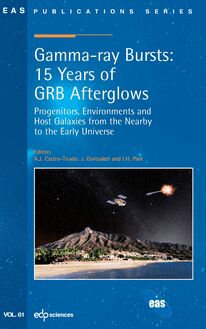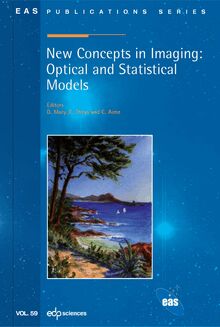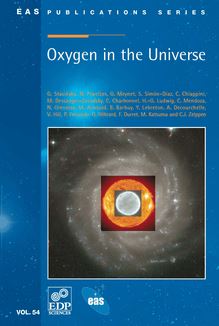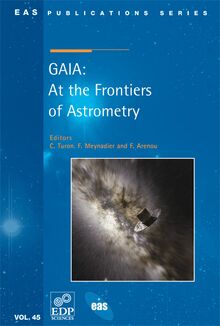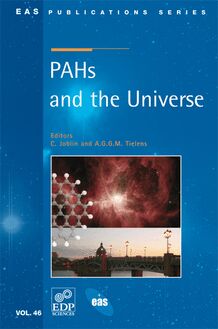GAIA: At the Frontiers of Astrometry , livre ebook
410
pages
English
Ebooks
2010
Obtenez un accès à la bibliothèque pour le consulter en ligne En savoir plus
Découvre YouScribe en t'inscrivant gratuitement
Découvre YouScribe en t'inscrivant gratuitement
410
pages
English
Ebooks
2010
Obtenez un accès à la bibliothèque pour le consulter en ligne En savoir plus
Publié par
Date de parution
01 mai 2010
Nombre de lectures
1
EAN13
9782759803019
Langue
English
Poids de l'ouvrage
20 Mo
The Symposium "Gaia : at the frontiers of astrometry", held in Sèvres (Hauts de Seine, France) from 7 to 11 June 2010, was the closing conference of the European Marie Curie ELSA network (European Leadership in Space Astrometry).
Gaia, selected as one of the cornerstones of the European Space Agency (ESA) Science Program in October 2000 and planned for launch in 2012, has been conceived in the wake of the success of the Hipparcos satellite, the first space astrometry mission, launched by ESA in 1989. Combining the power of discovery of a systematic and repeated survey of the sky with three complementary instruments (astrometric, photometric and spectroscopic) and extreme accuracy astrometry, Gaia will provide an unprecedented stereoscopic map of our Galaxy and the nearby universe.
The objectives of the Symposium were to present the results obtained in the framework of the ELSA network on the various aspects of the preparation of the data analysis and scientific exploitation of the Gaia mission. The science expected from Gaia has been put in the 2015 context, and progresses on parallel or connected topics have been presented : progress on other astrometric satellites, performance of light detectors in astronomy, processing of massive data sets, especially in astronomy, real-time classification of transients, access to massive data sets, and propects for ground-based observations in complement to astrometry.
Publié par
Date de parution
01 mai 2010
Nombre de lectures
1
EAN13
9782759803019
Langue
English
Poids de l'ouvrage
20 Mo
EAS Publications Series, Volume 2, 2002
GAIA: A European Space Project
LES HOUCHES
CENTRE DE PHYSIQUE
Les Houches, France, May 14-18, 2001
Edited by: O. Bienayme and C. Turon
17 avenue du Hoggar, PA de Courtaboeuf, B.P. 112, 91944 Les Ulis cedex A, France
First pages of all issues in the series are available at:
http://www.edpsciences.orgSponsored by
European High-Level Scientific Conferences programme
(HPCF-2000-00093)
ESA
CNES
CNRS (Formation Permanente)
PNG (Programme National Galaxies)
Figure explanation and credits
The GAIA satellite project
By the kind permission of ESA
ISBN 2-86883-597-X EDP Sciences Les Ulis
This work is subject to copyright. All rights are reserved, whether the whole or part of the material is
concerned, specifically the rights of translation, reprinting, re-use of illustrations, recitation, broad-casting,
reproduction on microfilms or in other ways, and storage in data banks. Duplication of this publication or
parts thereof is only permitted under the provisions of the French Copyright law of March 11, 1957.
Violations fall under the prosecution act of the French Copyright Law.
C5 EDP Sciences, Les Ulis, 2002
Printed in FranceForeword
A Summer School dedicated to the GAIA satellite, a cornerstone of theEuropean
Space Agency's science programme, was held in Les Houches (France), at the
"Centre de Physiques des Houches", from 14 to 18 May 2001. It was aimed at
engaging the curiosity, interest and participation of the next generation of
astronomers to the GAIA mission, and at guiding young scientists through the huge
scientific harvest expected from this highly exciting and challenging project.
The GAIA mission will provide a stereoscopic and kinematic map of our Galaxy
at micro-arcsec level accuracy, and will survey more than one percent of the
Galactic stellar population with the precision necessary to unravel its
composition, formation scenario and subsequent evolution. Additional scientific products
include characterisation of tens of thousands of extra-solar planetary systems,
stringent tests of general relativity, and a comprehensive survey of objects ranging
from minor bodies in our Solar System, through galaxies in the nearby Universe,
to some 500000 quasars.
The GAIA mission will give access to extremely high accuracy on distances and
kinematics, and will provide on-board radial velocities and multi-colour
photometry, i.e. to the full six-dimensional phase-space distribution function, combined
with astrophysical diagnostics, for one billion stars in our Galaxy and throughout
the Local Group.
A more complete description of the mission, and of its expected scientific
products, is available at http://astro.estec.esa.nl/GAIA
The lectures given in Les Houches reviewed the mission design and accuracy
performance, and the impact of the GAIA mission on various fields of
astrophysics: covering the history of the various stellar populations in our Galaxy
and in our neighbouring galactic companions, but also covering stellar physics
and evolution with characterisation of all types of stars, planetary formation and
census of extra-solar planetary systems in the solar neighbourhood,
fundamental physics with stringent tests of general relativity, etc. In each domain, the
most recent results were presented, along with the major key steps forward
expected from the GAIA data. Highlights of the presentations are summarised at
http://astro.estec.esa.nl/GAIA/resources/leshouches.html
This book presents the text of the lectures and presentations given during a
week in Les Houches to the 70 participants. The main goal of this conference was
to open this project to the full astronomical community, and to guide young
scientists in the direction of the most promising and exciting project concerning the
understanding of the history of the Universe from a complete survey and detailed
sampling of its local populations. The many fold improvement in the number of
stars and measurement accuracy will urge scientists to reconsider classical
methodologies and to develop new tools in order to be prepared for the analysis of the
future GAIA data.IV
The scientific organization of the meeting was in the hands of the Scientific
Organising Committee: O. Bieriayme, M.A.C. Perryman, C. Turon, A. Baglin,
J. Binney, A. Coradini. P. Fayet, K. Freeman, G. Gilmore, A. Gimenez,
M.T. Lago, M. Mayor, F. Mignard, H.W. Rix, and P.T. de Zeeuw.
We wish to thank particularly warmly the Strasbourg Observatory and the
Centre de Physique des Houches for ensuring that the School ran so smoothly. In
this respect, we are especially indebted to the Local Organising Comittee members,
and particularly to C. Bruneau and J. Pluet, and to the staff members of the Centre
de Physique, and of the Strasbourg and Paris Observatories.
We also wish to extend our gratitude to Cecile DeWitt-Morette who founded
the Summer School at Les Houches, fifty years ago.
In practice the meeting would not have been possible without strong local,
regional, national and European support. We gratefully acknowledge the
participation of the European High-Level Scientific Conferences programme
(HPCF2000-00093), and of ESA, CNES, CNRS (and more specifically the "Formation
Permanente"), Observatoire de Paris, Observatoire de Strasbourg, the Louis
Pasteur University, and the "Programme National Galaxies".
O. Bienayme
Observatoire Astronomique de Strasbourg, France (O.B.)
C. Turon
Observatoire de Paris-Meudon, France, (C.T.)
Top line from left to right:
A. Brown, M. Spite, S. Piquard, D. Pourbaix, V. Belokurov, M. Haywood,
D. Egret, F. Royer, M. Lattanzi, A. Siebert, J. Isern, C. Babusiaux, B. Famaey,
C. Reyle, V. Zappala, C. Bruneau, A. Omont, C. Cacchiari, U. Munari, A. Baglin,
O. Bienayme, X. Luri, J. Torra, J. Portell, S. Picaud, M. Mayor, J. de Bruijne,
E. Massana, S. Klioner, N. Christlieb, A. Digby,..., A. Gontcharov, F. Mignard,
V. Vansevicius, J. Knude, A. Kucinskas, D. Hestroffer, R. Ibata, D. Carollo,
N. Robichon, F. Arenou, A. Robin.
Bottom line from left to right:
A. Helmi, Y.-P. Viala, D. Katz, W. Gasti, C. Turon, A. Maeder, J.M. Carrasco,
M. Vaccari, A. Vecchiato, M.-T. Crosta, E. H0g, S. Torres Gil, L. Eyer,
A. Berdyugin.This page intentionally left blank List of Participants
Ansari Salim: ESTEC, Nordwijk, The Netherlands, salim.ansari@esa.int
Arenou Frederic: Observatoire de Paris, France, frederic.arenou@obspm.fr
Babusiaux Carine: Inst. Astron., Cambridge, UK, carine@ast.cam.ac.uk
Baglin Annie: Observatoire de Paris, France, annie.baglin@obspm.fr
Baraffe Isabelle: Ecole Normale Superieure, Lyon, France, ibaraffe@ens-lyon.fr
Barucci Antonella: Observatoire de Paris, France, antonella.barucci@obspm.fr
Belokurov Vasily: Theoret. Phys., Oxford, UK, vasily@thphys.ox.ac.uk
Berdyugin Andrei: Tuorla Obs., Turku, Piikkio, Finland, andrei@astro.utu.fi
Bertelli Gianpaolo: Univ. di Padova, Italy, bertelli@pd.astro.it
Bienayme Olivier: Observatoire de Strasbourg, France, bienayme@astro.u-strasbg.fr
Binney James: Theoret. Phys., Oxford, UK, binney@thphys.ox.ac.uk
Brown Anthony: Leiden Observatory, The Netherlands, brown@strw.leidenuniv.nl
Bruneau Chantal: Observatoire de Strasbourg, France, bruneau@astro.u-strasbg.fr
Cacciari Carla: Univ. di Bologna, Italy, cacciari@bo.astro.it
Carollo Daniela: Oss. Astron. Torino, Italy, carollo@to.astro.it
Carrasco Jose Manuel: Dept. Astron., Barcelona, Spain, carrasco@am.ub.es
Christlieb Norbert: Hamburger Sternwarte, Germany, nchristlieb@hs.uni-harnburg.de
Crosta Maria Teresa: Univ. Padova, Oss. Torino, Italy, crosta@to.astro.it
de Bruijne Jos: ESTEC, Noordwijk, The Netherlands, jdbruijn@astro.estec.esa.nl
Digby Andrew: Royal Observatory of Edinburgh, UK, apd@roe.ac.uk
Egret Daniel: Observatoire de Strasbourg, France, egret@astro.u-strasbg.fr
Eyer Laurent: Princeton University Obs., NJ, USA, leyer@astro.princeton.edu
Fabricius Claus: Copenhagen Univ. Obs., Denmark, cf@astro.ku.dk
Famaey Benoit: Universite Libre de Bruxelles, Begium, bfamaey@astro.ulb.ac.be
Fulchignoni Marcello: Observatoire de Paris, France, marcello.fulchignoni@obspm.fr
Gasti Wahida: ESTEC, Noordwijk, The Netherlands, wgasti@estec.esa.nl
Gilmore Gerry: Inst. Astron., Cambridge, UK, gil@ast.cam.ac.uk
Gontcharov Alexander: Lund Obs., Sweden, sasha@astro.lu.se
Grenon Michel: Observatoire de Geneve, Switzerland, michel.grenon@obs.unige.ch
Haywood Misha:e de Paris, France, Misha.Haywood@obspm.fr
Helmi Amina: MPI Astroph., Garching, Germany, ahelmi@mpa-garching.mpg.de
Hestroffer Daniel: Observatoire de Paris, France, hestro@bdl.fr
H0g Erik: Copenhagen Univ. Obs., Denmark, erik@astro.ku.dk
Ibata Rodrigo: Observatoire de Strasbourg, France, ibata@astro.u-strasbg.fr
Isern Jordi: IEECS, Barcelona, Spain, isern@ieec.fcr.esVIII
Katz David: Observatoire de Paris, France, david.katz@obspm.fr
Klioner Sergei: Lohrmann Obs., Dresden, Germany, klioner@rcs.urz.tu-dresden.de
Knude Jens: Copenhagen Univ. Obs., Denmark, indus@astro.ku.dk
Kucinskas Arunas: Inst. Theor. Phys., Vilnius, Lithuania, ak@itpa.lt
Lattanzi Mario: Osservatorio Astron., Torino, Italy, mariogl@tiscalinet.it
Lejeune Thibault: Obs. Astron., Coimbra, Portugal, lejeune@mat.uc.pt
Luri Javier: Dept. de, Barcelona, Spain, xluri@am.ub.es
Maeder Andre: Observatoire de Geneve, Switzerland, andre.maeder@obs.unige.ch
Masana Eduard: Dept. Astron., Barcelona, Spain, emasana@am.ub.es
Mayor Michel:e de Geneve,, michel.mayor@obs.unige.ch
Mignard Frangois: OCA/CERGA, Grasse, France, francois.mignard@obs-azur.fr
Munari Ulisse: Inst. di Astron., Univ. di Padova, Italy, munari@astras.pd.astro.it
Omont Alain: Institut d'Astrophysique de Paris, France, omont@iap.fr
Ferryman Michael: ESTEC, Noordwijk, The Netherlands, mperryma@astro.estec.esa.nl
Picaud Sebastien: Observatoire de Besangon, France, picaud@obs-besancon.fr
Piquard Sandrine:e de Strasbourg,, piquard@astro.u-strasbg.fr
Portell Jordi: Un. Pol. Catalun, Barcelona, Spain, portell@ieec.fcr.es
Pourbaix Dimitri: Universite Libre de Bruxelles, Belgium, pourbaix@astro.ul
